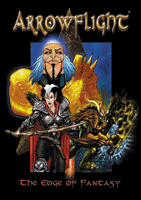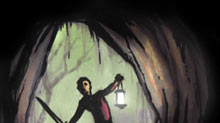by Demian Katz
 Publishers just can't seem to help themselves. Even though Dungeons
& Dragons has had a firm hold on the fantasy role-playing game
market more or less since the beginning of time, a year doesn't go by
without several new fantasy RPGs coming out, each claiming to be the
next big thing. Most of the time, they're dreary rip-offs utterly
lacking in creativity or purpose. Every once in a while, something good
appears, like the sadly ill-fated Enchanted Worlds game of 1999.
Whether good or bad, though, the question on everyone's mind is "Why
another fantasy role-playing game?"
Publishers just can't seem to help themselves. Even though Dungeons
& Dragons has had a firm hold on the fantasy role-playing game
market more or less since the beginning of time, a year doesn't go by
without several new fantasy RPGs coming out, each claiming to be the
next big thing. Most of the time, they're dreary rip-offs utterly
lacking in creativity or purpose. Every once in a while, something good
appears, like the sadly ill-fated Enchanted Worlds game of 1999.
Whether good or bad, though, the question on everyone's mind is "Why
another fantasy role-playing game?"
In the case of Arrowflight, Deep7 Publishing's recent entry into the fray, this
question is actually addressed by an author's note. If you dig through the
peculiar mixture of bravado and modesty that characterizes this introduction
(and much of the rest of the book, for that matter), you'll find that the
answer is partially "because we've been working on it for decades" and
partially "because it's different, yet not too different." Though I'm not
sure I'd go along with the authors and call this game "The Edge of Fantasy,"
I certainly can't dispute that the game is somewhat different.
The game's setting, which is introduced in advance of any rules, certainly
serves to support the claims of the author's note. Although the background
material provided in the rulebook is far from comprehensive, its interesting
details on holidays, local customs, religious beliefs and history do suggest
fairly lengthy development time – it's not just a list of random names and
places; some thought obviously went into making it consistent, believable
and interesting. The setting also manages to be comfortably familiar
without being entirely tedious and derivative. The game world is
populated by the usual elves, dwarves and orcs, and no goofy names are made
up to disguise this fact; still, enough flavorful details (like the
revelation that humans may be the unpredictable offspring of elves and
demons) are added to the expected genre conventions to keep things
interesting. No awards are going to be won here for originality, but this
is a respectably solid implementation of a proven formula.
After twenty-some pages of setting and the obligatory (and rather
apologetic-sounding) introduction to role-playing, the rulebook
introduces the game system by discussing character creation. It was at
this point that I began to lose faith in the game's quality. I had
already noticed a number of typos and the fact that the book's artwork
is an uneven mix of beautiful original works, not-so-beautiful original
works and what appears to be clip art, but these things are to be
expected from a small press publication. What really began to raise
concerns, though, was another common small press problem: the book's
organization is not all that it should be. For the most part, it's not
hard to find the general rules that you need (despite the book's sinful
lack of an index), but there are a number of small-yet-significant
details, particularly regarding prerequisites for skills, spells and
combat abilities, which are scattered throughout the book and never
summarized satisfactorily. It could therefore be fairly common to
unwittingly create an illegal character by neglecting to notice that you
can't take points in Literary Skills without first spending points on
Education, or that you can't wear chain mail or heavier armor without the
Armed Combat Skill: Soldier skill (a fact which is mentioned in a couple
of different places, but not necessarily the most obvious ones). Picky
details like this are the exception in the game, but this makes
the ones that do exist all the more irritating.
Organizational problems aside, though, character creation is the
place where the game shines the brightest. Characters consist of eight
attributes and numerous skills; nothing too new here, though I love the Mana
and Spirit attributes, which measure a character's connection to the
physical and spiritual planes – run out of Mana and you're a ghost, run out
of Spirit and you're a soulless undead beast. A player's race determines
limits on the attributes and offers some special abilities, but beyond this,
the main limit on character creation is the player's imagination. Players
aren't restrained by character classes (there aren't any) or threatened by
bad luck (there's no dice-rolling involved in character generation), so it's
not hard to create a balanced representation of almost any character
concept simply by spending points in the right places. Even individual
spells can be completely customized – a wide variety of templates are
available, and they can be modified using a point based system. A
complex casting procedure can be used to balance out the difficulty of
achieving spectacular results. As a GM whose players often try to create
characters that are hard to define in the restrictive game terms of most
systems, I was grateful for Arrowflight's flexibility.
Unfortunately, the game mechanics at the heart of Arrowflight's system
please me considerably less than the character creation rules. The basic
mechanic is fairly simple in principle, but is more complicated than it
needs to be, especially for players with a
math phobia. It goes something like this: you roll a number of six-sided
dice equal to the value of the attribute related to the skill being tested,
and if any one of these dice comes up less than or equal to the actual value
of the tested skill, the player is successful. Modifiers can be made to the
number of dice rolled and/or to the skill value being tested. There are
also rules for critical successes and failures, and for testing skills which
have no points in them. Opposed rolls are dealt with by comparing the
number of successful dice rolled by each participant. The magic and combat
systems both make use of this mechanic, but they add additional mathematics,
timing concerns and other complications to the mix. As with character
creation, there are just enough annoying and scattered little details to
make things more irritating than they should be. The system seems to work,
but I wouldn't describe it as elegant.
Once all of the mechanics have been covered, the final portion of the
book provides information of use to the Game Master. First there's a
bestiary containing some ordinary animals, the usual fantasy beasts
(with some clever twists) and a few original creations. This is
followed by some brief advice for the novice GM and some miscellaneous
rules for things like poison, aging and magic items. Finally, there's
one fully developed adventure plus a couple of seeds. The full
adventure, Darkmoon Rising, struck me as a bit of an odd choice for
inclusion in the rulebook. Though a solid adventure which I happily used
for my playtest session, its tone is quite gruesome and horrific, and I
would have expected something more prototypically fantasy-oriented to
have been used as an introduction to the game. Also problematic is the
fact that, about halfway through the adventure, it stops listing
statistics and requires the GM to really think on his feet.
Again, there's nothing wrong with this in general, but a little
more hand-holding might have been wise to help role-playing novices get
the idea.
My strategy in dealing with both the looseness of the provided adventure and my
dislike of the complex game system was to play
Arrowflight in the style of Deep7's earlier claims to fame, the 1PG
mini-RPGs. The combination of this fast-paced, rules-loose style with the
balanced, well-developed characters Arrowflight's wonderful
character generation rules provides led to very satisfying game sessions.
Because it's so easy to use Arrowflight's strengths and ignore
its weaknesses, it's certainly worth looking into as a new fantasy game
system. It's also worth noting that the game is well-supported on the
publisher's web page (there's a spell creation worksheet there that's
particularly valuable). The game doesn't strike me as an entirely
effective whole, but it has a number of good parts, and encourages the
GM to use them creatively. This attitude in gaming products is
commendable, and I look forward to Deep7's continuing contribution to
the world of gaming.




